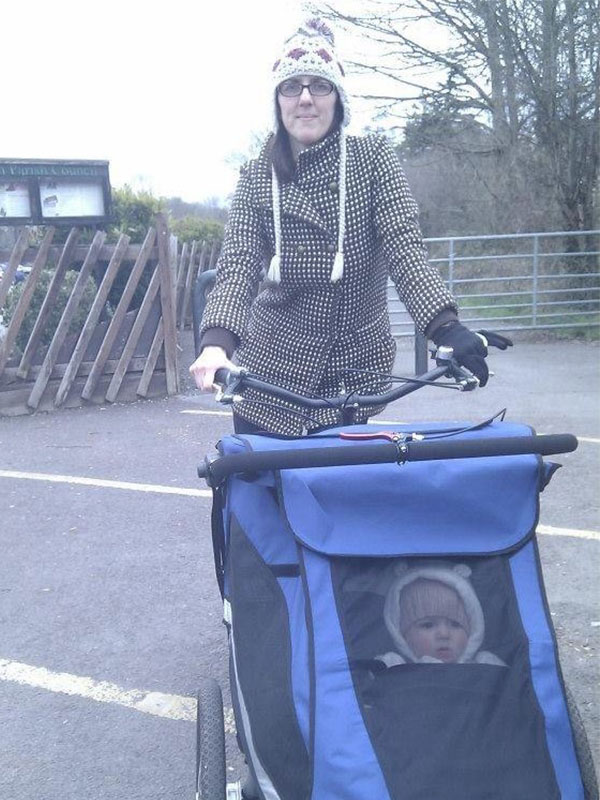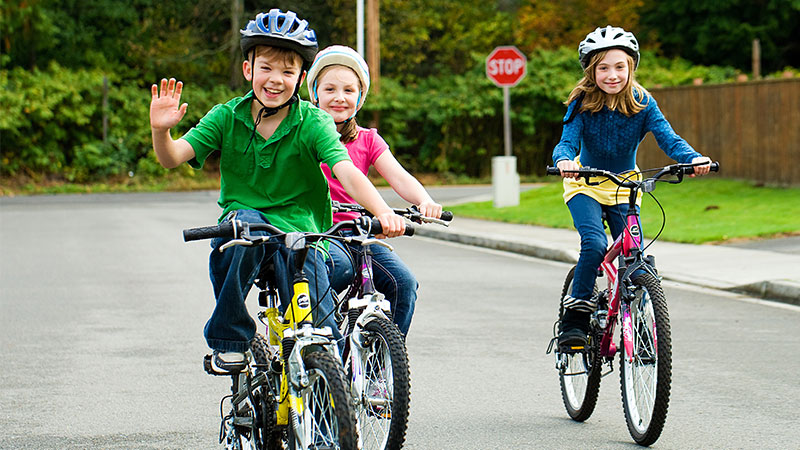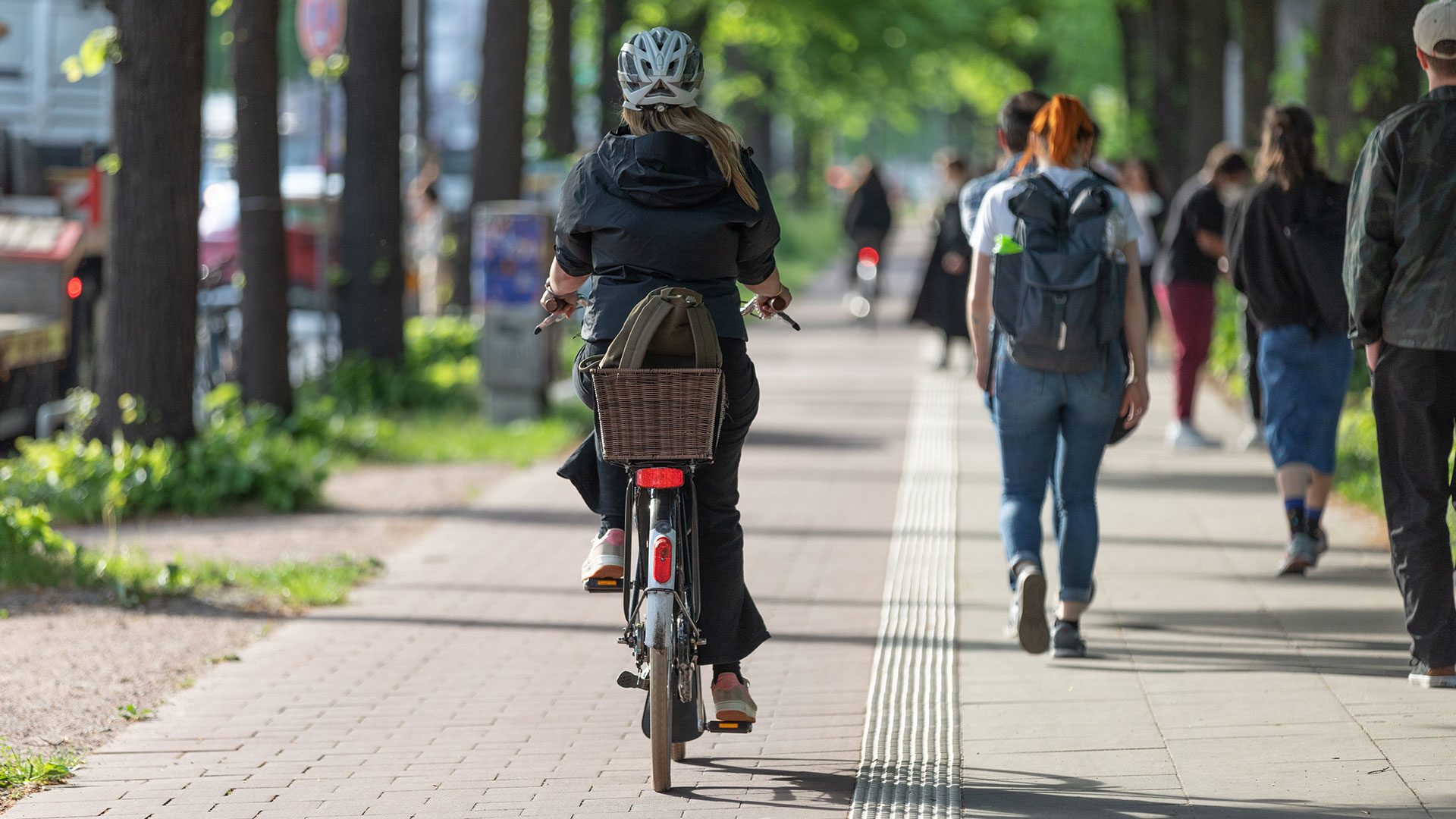A problematic practice? Mothers cycling with their children in the UK

As a mother who doesn’t drive and has cycled with my son (now 11) in various forms since he was 7 weeks old, my own experiences both positive and negative had left me intrigued to find out how other mothers were traversing the challenge of cycling with young children. Were my experiences typical of others cycling in the UK? Did other mothers have to plan where and when they can ride with their children due to lack of safe cycle infrastructure? Have they encountered judgement from others for their choice of transport and how do they ensure high spirited children concentrate on their surroundings and not get distracted by passing cats or dogs!
What better way to find out than to undertake a PhD researching mothers cycling with their children in the UK. However, before putting together my research methods I started looking into why currently so few mothers’ cycle with their young children in the UK.
Fear of cycling
The most common reasons related to women’s fear of cycling on busy roads and mixing with other motorised forms of traffic. Thus, if women are not comfortable cycling on their own, road safety concerns are further amplified when a young child or multiple children are in tow. Cycling with children on busy roads can also be viewed negatively and call into question the mothering skills of those that do. It is also put forward that complications arise due to the pull of competing demands, and the logistics of cycling with children being too difficult for mothers to overcome. That is, the complications of trying to juggle the undertaking of care duties such as escort trips to education sites combined with working in full or part-time employment make finding time for cycling difficult. Based with an understanding of why more mothers weren’t cycling, I was keen to find out how those who were, were able to navigate the aforementioned barriers. A mixed method approach was pursued, including carrying out 3 focus groups with 10 women who work in the cycling industry representing organisations such as Cycling UK, Joyriders, Sustrans, Bikeability instructors, Breeze champions, business owners (family cycling related) community cycling officers, cycling advocates and campaigners.

The findings from the focus groups helped shape a survey which was distributed via social media and completed by 1,351 mothers in the UK asking questions such as the cost of their cycle equipment, where they stored their cycles, favoured types of infrastructure and motivations for cycling with their children. In addition, 30 semi-structured interviews were conducted with respondents of the survey, carefully chosen to represent mothers using different cycle configurations, varying number of children and living in different geographical areas of the UK including a mix of cities, suburban and rural areas.
The socio-demographic of cycling mothers in the UK
The household income of the mothers who were surveyed was much higher than the national average, with 83% of participants living in a household earning above the median average household income of £30,500. In addition, 30% of all mothers surveyed were living in a household that earns above £80,000 per annum after tax. Similarly, the education levels of those surveyed was high, with 40% having a degree (or equivalent) and a further 49% at postgraduate level. Of course, it is important to note that the mothers taking part in this research were purposively sampled so a degree of bias may be evident here.
Moreover, 93% of mothers who completed the survey in this research were from a white background with only 2% from a mixed background, 2% Asian background and the remainder from other ethnic groups. However, existing literature suggests that cycling rates amongst ethnic minority groups are extremely low in the UK, particularly amongst women. This suggest therefore, that the low numbers of women from ethnic minority backgrounds taking part in this research are most likely representative of the wider trend of low numbers cycling from different ethnic minority groups.

What impact does infrastructure have when cycling with children?
Perhaps unsurprisingly, mothers expressed a preference for infrastructure which was separated from motorised forms of transport, such as shared use paths and protected cycle paths but also quiet roads. However, depending on the type of cycles and equipment they were using this could cause certain issues. For instance, many mothers had to navigate barriers such as guard railing or other obstructions on shared use routes, which meant those using non-standard cycles such as cargo cycles, trailers and child seats often struggled to get through and sometimes had to choose a different route. As this research was carried out across the whole of the UK, there were many mothers who lived in areas with no cycle infrastructure at all.
In many cases mothers would resort to cycling with their children on footways, which they knew technically they weren’t meant to, but felt the alternatives (riding on busy roads) was unsafe. This often led to feelings of guilt because they felt they would be judged by other people for doing so. Conversely many mothers also felt they would be judged if they cycled with their children on the road, due to potential dangers of mixing with motorised traffic.
Most mothers taking part in this research wanted better infrastructure to make their own cycling practice safer but also to make it more convenient. For example, whilst a preference for protected cycle lanes or quiet roads existed, also of importance was the location of infrastructure with a need for it to enable the types of journeys mothers carry out. Therefore, linking together networks of routes that facilitated journeys between their homes, education settings, employment and other locations such as shops, leisure centres and places of worship was key.
Are there any negatives to cycling with children?
Unfortunately, bad driving and aggression from other road users were all too common. With just under a quarter of mothers surveyed having faced close passes, and more than a third having suffered from verbal abuse when cycling with their children. These incidents frequently left mothers questioning their choice to cycle with their children due to concerns about their safety. However, because the majority of mothers were highly motivated to cycle, in most circumstances they were able to rationalise the negative experiences and continue with their practice. Indeed, cycling with children was overwhelmingly deemed worth the effort and mothers shared countless examples of the pure enjoyment experienced when cycling together.
Organisational skills
The logistics of trying to cycle with multiple children and those of different ages were frequently highlighted in the interviews. For example, if children are cycling on their own bicycles, the mother must ensure they had the skills to cycle safely. We all know mums are experts at multitasking but cycling with young children elevated this to a whole new level. Trying to predict what other road users are doing, while simultaneously instructing children to stop/start/slow down, watch out for dogs approaching and so on can be exhausting. In addition, if cycling with children of different ages, trying to keep their speeds at a similar pace can be tricky plus managing sibling bickering whilst cycling was also highlighted as another skill required to master.
Many mothers interviewed also pointed out, that while they may have one child who was capable (and willing) to follow instructions, the personality of their other, let’s say strong-willed, child, would mean some routes were just not possible because their behaviour was just too unpredictable.
Is cycling costly for mothers?
It was apparent that cycling with children could also be expensive. The cost of child carrying cycles can range from very little, if gifted or purchased second-hand, to over £5k for some of the e-assist cargo cycles or triplet style cycles. The survey asked mothers to add up the cost of their current configurations. Just over 60% of those surveyed had spent over £750 and 30% had spent over £2,000 on their equipment. Furthermore, mothers frequently had to purchase additional equipment to make cycling comfortable and safer for themselves and their children. This included materials to keep themselves and children dry and warm, such as waterproofs and rain covers. Or items to make themselves more visible such as flags, hi visibility clothing and stickers attached to their cycles. Mothers were also increasingly investing in cycle cameras to record incidents of dangerous or careless driving around themselves and their children.

Getting more mothers cycling
The mothers taking part in this research were from a specific socio-demographic as outlined above. It was also apparent the majority of mothers cycling with their children in this study had previously cycled on a regular basis and therefore were comfortable cycling with their children because they were confident cyclists and felt they had the necessary skills to do so. They also attached strong meanings to cycling, believing it was the right thing to do with their children due to the health, environmental and wider benefits to society. This begs the question of how to get more mothers cycling who perhaps don’t share these motivations and are not confident cyclists?The obvious answer might be to improve cycle infrastructure. Whilst the UK has some pockets of ‘safe’ cycling infrastructure, the financial and political support given to cycling by both national governments, but also individual local authorities often result in a cycling ‘postcode lottery’ whereby the quality of cycle infrastructure is of differing standards across the UK. However, it is unlikely that infrastructure alone will increase or make cycling more diverse and attract more women and mothers to the practice. For instance, overcoming the lack of a positive cycling culture and reversing the negative meanings currently associated with cycling in the UK also appears a monumental task, given ongoing social and mainstream media coverage of cyclists as rule breakers, dangerous and arrogant, or that cycling is a dangerous activity and therefore off-putting especially to mothers travelling with children.Add in, other factors such as the affordability of cycling equipment, issues with storage and juggling care duties and employment means attracting more mothers to cycle with their kids as problematic. Perhaps with any complex issues, the solution requires a mix of measures. Implementation of safe infrastructure – of course! But such infrastructure must cater for the types of multi-trip journeys that mothers frequently carry out. Schemes to help women gain confidence to cycle via cycle training, led and group rides and are invaluable in providing women with the skills and confidence needed to take to two or three wheels – more funding for these types of scheme please! Because, if more women become confident cyclists, then down the line they might consider cycling with their children and what better way to normalise bike riding and help chip away at the negative narrative around cycling in the UK than seeing mothers cycling with their children!
Our experts are happy to assist you
Experts team Transport strategy, research & economics
Transport strategy, research & economics
Discover our expertise in transport research and evaluation, developing citywide mobility strategies and Dutch heritage in active travel delivery.
